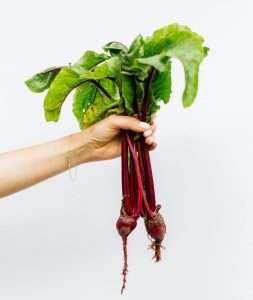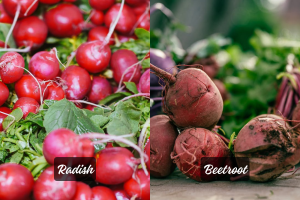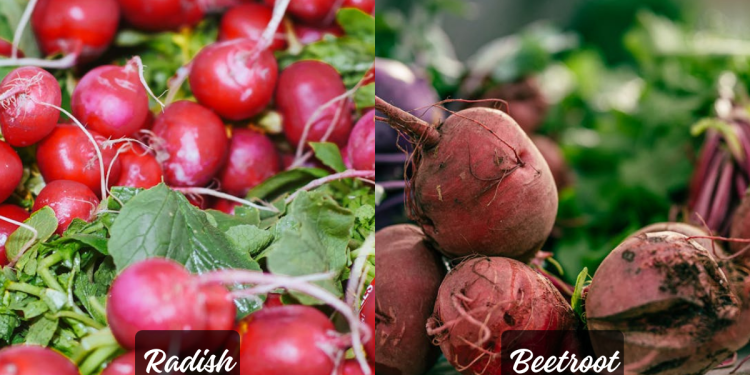If you're seeking a nutritious and tasty root vegetable, you may be torn between radishes and beets. They have advantages and distinct features that set them apart from other veggies.
As you read, we'll compare radishes with beets regarding nutrients, flavor, and preparation techniques. We’ll also give you some suggestions on how to include them in your meals.
By the conclusion of this article, you'll be able to choose which root vegetable best meets your needs and tastes better—or perhaps you'll enjoy both!
An Overview
Radish
Radishes, belonging to the Brassicaceae family, are crisp, colorful root vegetables celebrated for their peppery flavor. Common types include:
- Daikon Radish: Recognized for its elongated shape and mild taste, it is often used in Asian cuisine.
- Red Radish: This small, round variety is a staple in salads, offering a vibrant red hue and a distinct bite.
- Black Radish: Known for its dark exterior and pungent flavor, it adds a bold twist to dishes.
Nutritional Composition:
Radishes are low in calories but pack a nutritional punch. They are an excellent source of vitamin C, potassium, and fiber. Additionally, radishes contain antioxidants like anthocyanins, contributing to their health benefits.
Also Read: The 7 Cucumber Growing Stages Explained: From Seed to Salad
Beet

Beets, members of the Chenopodiaceae family, are versatile root vegetables with a rich, earthy flavor. Various beet varieties offer diverse colors and characteristics:
- Red Beet: The most common type, recognized for its deep red color and sweet taste.
- Golden Beet: Boasting a vibrant yellow hue, these beets offer a milder flavor than their red counterparts.
- Chioggia Beet: Also known as candy cane or striped beet, it features distinctive pink and white rings when sliced.
Nutritional Content:
Beets are nutritionally dense and provide essential vitamins and minerals. They are particularly high in folate, manganese, and potassium. The rich color of beets indicates the presence of betalains, powerful antioxidants with anti-inflammatory properties.
Also Read: Pitaya vs Pitahaya Fruit: Unveiling the Major Differences
Health Benefits
Radish

Radishes, often enjoyed for their crisp texture and peppery taste, offer various health benefits attributed to their rich nutritional profile.
Rich Source of Vitamins and Minerals:
Radishes are a notable source of essential vitamins and minerals. They are exceptionally high in vitamin C, a potent antioxidant crucial for skin health and immune system support. Additionally, radishes contain potassium, aiding in maintaining proper blood pressure levels and supporting heart health.
Potential Health Benefits:
- Digestive Health: Radishes are known to promote digestion. Their natural fiber content adds bulk to stool, preventing constipation and supporting a healthy digestive system.
- Immunity Boost: The high vitamin C content in radishes strengthens the immune system. This vitamin stimulates the production of white blood cells, enhancing the body's ability to fight infections.
Antioxidant Properties and Role in Disease Prevention:
Radishes are rich in antioxidants, including anthocyanins, quercetin, and folic acid. These compounds are vital in neutralizing free radicals, reducing oxidative stress, and potentially lowering the risk of chronic diseases, including certain cancers.
Beet

Beets, with their distinctive earthy flavor and vibrant colors, offer a range of health benefits, making them a valuable addition to a balanced diet.
High Levels of Antioxidants and Phytonutrients:
Beets contain betalains, unique pigments with potent antioxidant properties. These compounds help neutralize free radicals, reducing oxidative stress and inflammation in the body.
Cardiovascular Benefits and Blood Pressure Regulation:
- Nitric Oxide Production: Beets are rich in nitrates, which the body converts into nitric oxide. Nitric oxide helps dilate blood vessels, improving blood flow and potentially lowering blood pressure.
- Heart Health: Regular consumption of beets has been associated with improved cardiovascular health. The combination of antioxidants, fiber, and nitrates reduces the risk of heart-related issues.
Potential Role in Enhancing Exercise Performance:
Due to its nitrate content, Beet juice has gained attention for its potential to enhance exercise performance. Nitric oxide improves oxygen utilization, increasing endurance and reducing the oxygen cost of exercise.
Also Read: Jalapeno Plant Stages: Step by Step From Seed to Harvest
Comparing Health Impact
Radish vs. Beet: A Health Showdown
Antioxidant Content and Free Radical Scavenging Abilities:
Radish: The Peppy Defender
Picture the radish as your front-line warrior against oxidative stress. Packed with antioxidants like anthocyanins and quercetin, radishes wage war on free radicals, the sneak attackers causing cellular damage. The vibrant hues of radishes aren't just for show; they signify a colorful arsenal ready to neutralize these troublemakers.
Beet: The Bold Betalain Guardian
Beets, on the other hand, unleash betalains, their superhero pigments. These mighty compounds swoop in, armed with free radical-fighting prowess. The betalains in beets lend that deep red or golden glow and actively contribute to reducing oxidative stress, promoting cellular harmony.
Effects on Heart Health and Cholesterol Levels:
- Radish: Radishes, with their potassium punch, play a crucial role in maintaining a heart-friendly rhythm. Potassium helps regulate blood pressure, reducing strain on the heart. Furthermore, their fiber content aids in managing cholesterol levels, paving the way for a heart that beats to a healthy tune.
- Beet: Beets bring a unique player to the cardiovascular arena—nitric oxide. By converting nitrates into nitric oxide, beets help widen blood vessels, ensuring smooth blood flow. This not only supports heart health but may also contribute to maintaining optimal blood pressure. Beets, with their heart-loving attributes, navigate the circulatory system with finesse.
Impact on Digestion and Gastrointestinal Health:
- Radish: Radishes, with their crunchy texture and fiber content, are like a refreshing breeze for your digestive system. They add bulk to stool, preventing sluggishness and promoting regularity. Radishes don't just spice up your salads; they keep your digestive engine humming along smoothly.
- Beet: With their fiber content and unique nutrients, beets are navigators for your gut. They promote a healthy digestive environment, supporting the growth of beneficial gut bacteria. This not only aids digestion but also contributes to overall gastrointestinal well-being.
Also Read: Plum vs Pluot: Key Differences Unveiled!
Nutritional Values: Radish vs. Beet

Radish:
- Vitamins: Rich in vitamin C, promoting immune health.
- Minerals: High potassium content for blood pressure regulation.
- Antioxidants: Anthocyanins and quercetin combat free radicals.
- Digestive Aid: Fiber content supports digestion.
Beet:
- Antioxidants: Betalains provide potent free radical scavenging.
- Nitrates: Converted into nitric oxide, enhancing cardiovascular health.
- Fiber: Supports digestive health and beneficial gut bacteria.
- Nutrient Density: High in folate, manganese, and potassium.
Both radishes and beets bring a nutrient-packed punch to the table. Radishes shine with immune-boosting vitamin C and potassium, while beets stand out for their unique betalains, cardiovascular support through nitric oxide, and a nutrient-rich profile including folate and manganese.
Also Read: Bell Peppers Growing Stages: From Seed to Harvest
Culinary Uses and Recipes
Incorporating Radishes:
- Salads: Slice radishes thinly for a crunchy, peppery addition to green salads. Their vibrant color adds visual appeal.
- Pickles: Quick-pickle radishes with vinegar, sugar, and salt for a zesty snack or garnish.
- Side Dishes: Sauté radishes with butter and herbs for a delightful and unexpected side dish. The cooking process mellows their spiciness.
Creative Ways to Prepare and Enjoy Beets:
- Roasting: Roast beets with olive oil and herbs for a caramelized sweetness. Perfect as a standalone side or added to grain bowls.
- Juicing: Blend beets into a vibrant juice with carrots and apples for a nutrient-packed and refreshing drink.
- Pickling: Pickled beets bring a tangy twist to salads or serve as a colorful and tasty side. Customize the pickling liquid with spices for added flavor.
Also Read: Plant Food vs. Fertilizer: 8 Key Differences Explained
Conclusion
In conclusion, radishes and beets contribute both vibrant flavors and unique nutritional benefits to culinary creations. From the peppery crunch of radishes in salads to the sweet versatility of beets in roasts and juices, these root vegetables showcase their culinary prowess, enriching taste and health.

























